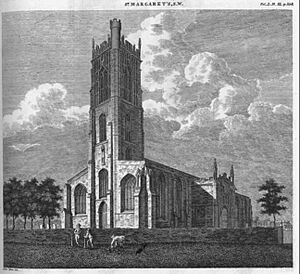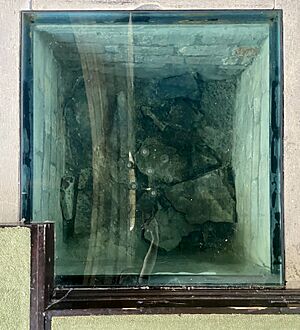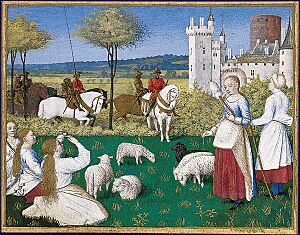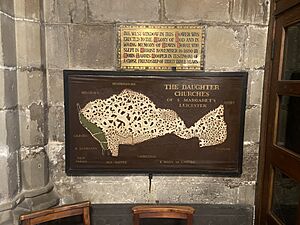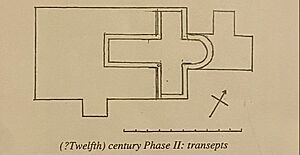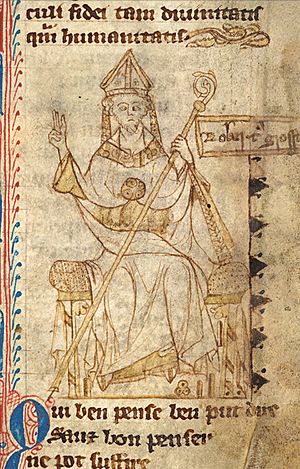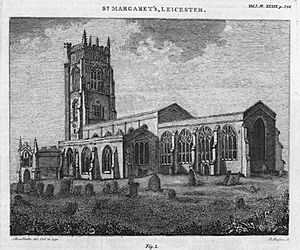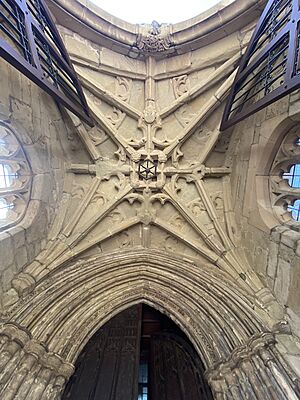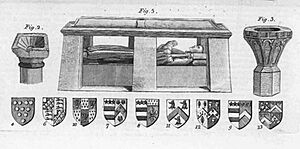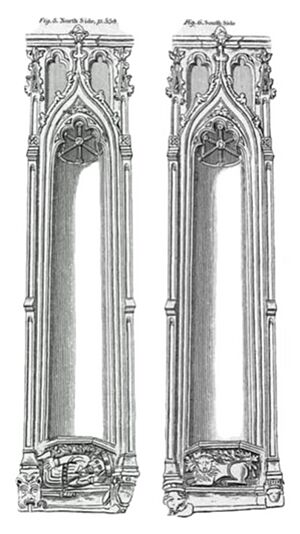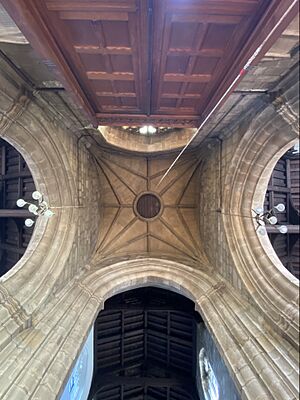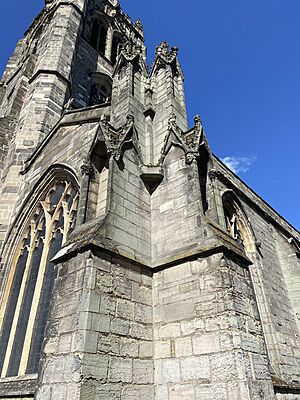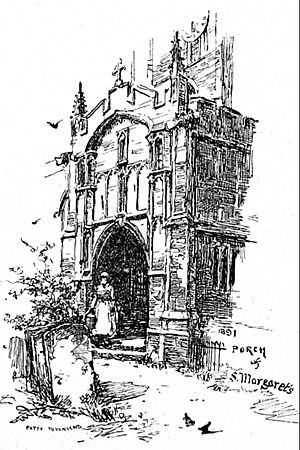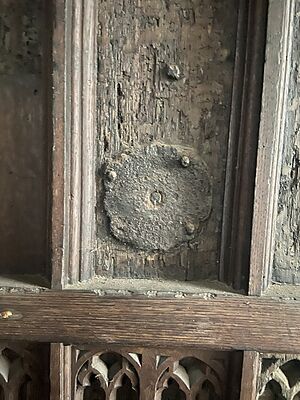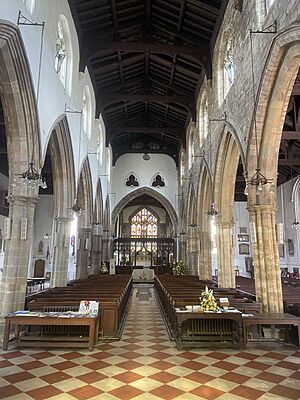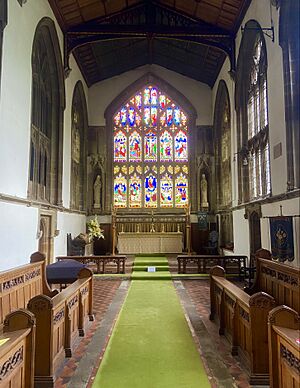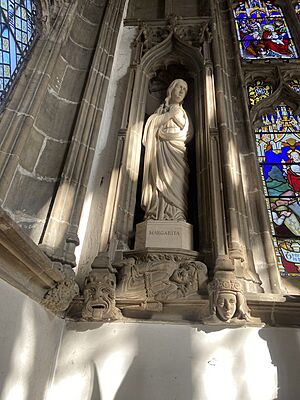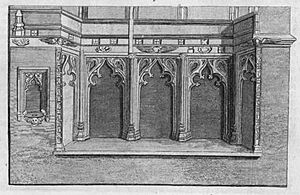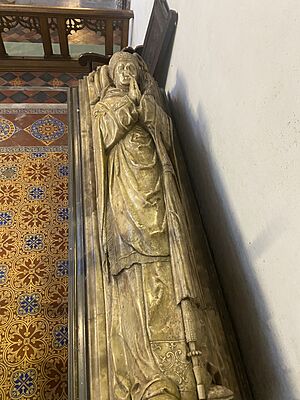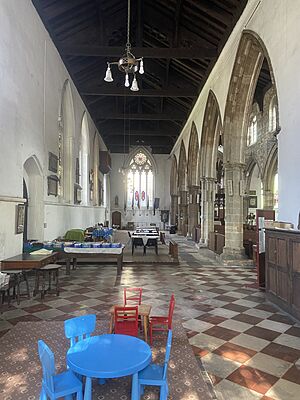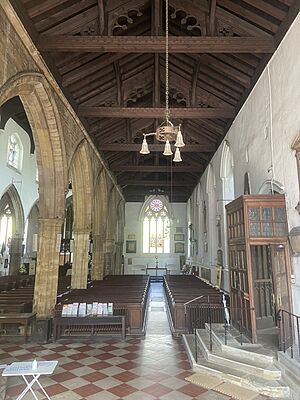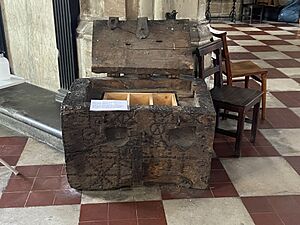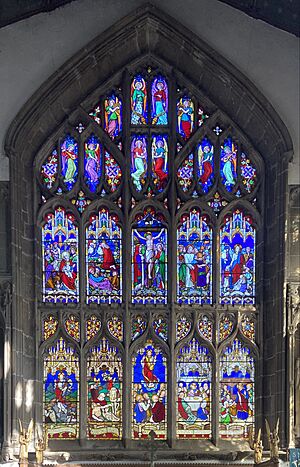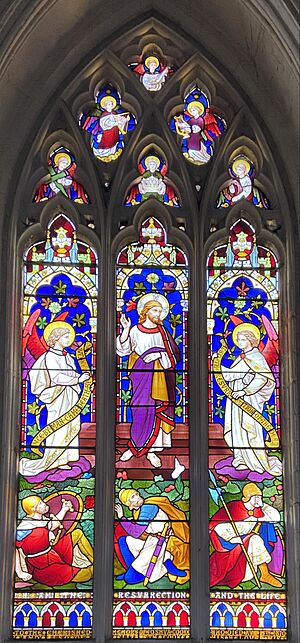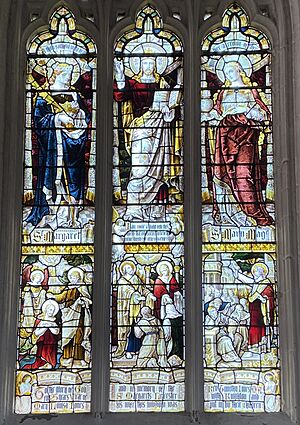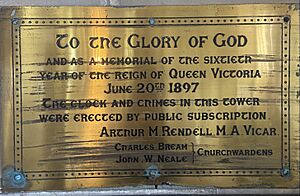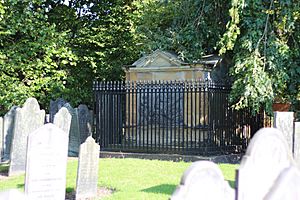St Margaret's Church, Leicester facts for kids
Quick facts for kids St Margaret's Church, Leicester |
|
|---|---|
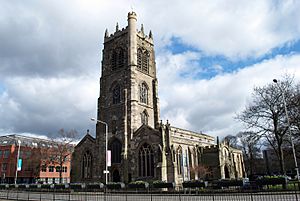
View of west front and tower
|
|
| 52°38′25″N 1°08′11″W / 52.64030°N 1.13625°W | |
| Denomination | Church of England |
| Previous denomination | Roman Catholic |
| Churchmanship | Broad church |
| History | |
| Status | Parish Church Prebendal Church |
| Dedication | Margaret of Antioch |
| Specifications | |
| Bells | 14 |
| Administration | |
| Parish | The Abbey |
| Archdeaconry | Leicester |
| Diocese | Leicester |
| Province | Canterbury |
St Margaret's Church, Leicester is a very old Anglican parish church in Leicester, England. It was built on even older foundations from Anglo-Saxon times. It's one of the five medieval churches still standing in Leicester's Old Town. People in the Middle Ages believed it was the "mother church" of the area, possibly dating back to 679 AD.
What makes St Margaret's special is that it's the only medieval church in Leicester that was built outside the old Roman walls. It used to serve a huge area, including both suburbs and countryside. For many centuries, from 1199 to 1879, it was a special "prebendal" church linked to the Bishop of Lincoln. Even today, it keeps the honorary title of a prebendal church.
The church has been rebuilt at least four times, most notably in the 15th century. Historians have called it "the fairest parish church in Leicester." Its tall tower and unique south porch make it one of Leicester's most recognizable historic buildings. It's also famous for its 14 bells, with ten of them being in the tower since the 1600s. St Margaret's is a Grade I Listed Building, meaning it's a very important historic site.
Contents
- A Look at St Margaret's History
- Roman and Medieval Times
- How the Church Might Have Started
- Anglo-Saxon Church
- Why "St Margaret"?
- St Margaret's After the Norman Conquest
- 12th Century Changes
- 13th Century Growth
- 14th Century Challenges
- 15th Century Rebuild
- Early 16th Century
- St Margaret's Before the Reformation
- The Reformation and Civil War
- Later Centuries
- 19th Century Changes
- 20th and 21st Centuries
- The Church Building
- Stained Glass Windows
- Organ
- Bells
- Churchyard
- Images for kids
A Look at St Margaret's History
St Margaret's Church has a long and interesting history, possibly starting as early as the 600s. The building you see today has parts from the 12th, 13th, and mostly 15th centuries. Digs have even found Saxon foundations from the 9th or 10th century.
In medieval times, people saw St Margaret's as the main church of Leicester. They thought it was the oldest Christian place of worship in the town. It was even believed to be the former cathedral for Anglo-Saxon bishops between 679 and the 870s. Because of this, it became a very important place for all of Leicester's churches and monasteries. It was the main destination for the town's big annual procession on Whit Monday.
After the Norman Conquest in 1110, St Margaret's was one of only two churches in Leicester controlled by the Bishop of Lincoln. This was because it was the main church for a large area called the Bishops Fee, which belonged to the Diocese of Lincoln. St Margaret's also had a smaller church, or "chapel of ease," in Knighton.
From the late 1100s, St Margaret's became a "prebend" church. This meant it was under the direct control of a senior clergyman called a prebendary, not the usual church authorities. This special status gave it more independence. The Bishop of Lincoln could also collect taxes from the eastern and northern parts of Leicester's suburbs, which helped pay for the church's grand construction.
Over time, as Leicester grew, many new churches were built. Their parishes were created from St Margaret's huge original territory. In the 1900s, parts of the old town were cleared for new roads, which changed the area around the church. The special prebend status ended in 1879, making it an honorary title today.
St Margaret's has been connected to many important church leaders and people from Leicester. These include early bishops of Leicester and famous figures like Thomas Wolsey.
Roman and Medieval Times
St Margaret's Church stands just outside the old Roman city walls of Ratae Corieltauvorum (ancient Leicester). The area where the church is now was once a Roman cemetery.
After the Romans left, the areas outside the city gates slowly became suburbs. St Margaret's Church served these growing communities. The path along the northern wall, called Sanvey Gate, became a main route for religious processions. Its name comes from "Sacra Via," meaning "Holy Way."
How the Church Might Have Started
Traditional Story
In the Middle Ages, many believed St Margaret's was Leicester's "mother church." This meant it was the oldest Christian place of worship and even the cathedral for early bishops of Leicester (679–874 AD). This idea was supported by old religious traditions, like the Whit Monday procession.
The tradition suggests the church started in the 600s, perhaps after Christian missionaries arrived in 653 AD, or after the Leicester bishopric was created in 679 AD. It was certainly before the last bishop left in 874 AD. Today, some people think St Nicholas Church might be older because it has more surviving ancient parts.
A Saint's Burial Site?
One modern idea is that St Margaret's was built over the grave of a local Christian saint from Roman times. This theory comes from the fact that the church is in an old Roman cemetery. Many churches, like St Peter's in Rome, were built this way. However, there's no clear evidence for this idea, and the church is named after Margaret of Antioch, not a local saint.
A Church for Vikings?
A more recent idea is that St Margaret's was built for the Viking people who settled in Leicester around 874-877 AD. For about 40 years, Vikings ruled Leicester. This theory suggests that the Vikings, after converting to Christianity, built or rebuilt the church.
This idea is supported by street names in the eastern and northern suburbs, like Church Gate and Humberstone Gate. The word "gate" comes from the Old Norse word gata, meaning "street." This shows a strong Viking influence in these areas, which were part of St Margaret's parish.
Anglo-Saxon Church
No matter how it started, St Margaret's definitely existed before the Norman Conquest. This was proven when a small part of the church's floor was dug up. It showed Saxon foundation stones from the late 900s or early 1000s. You can still see these stones through a glass window in the floor.
Earliest Stone Church
The few stones visible under the floor show a church that was similar to other early English churches. These remains are thought to be from around 1010 AD, just 50 years before the Normans arrived.
Viking Connection
As mentioned, the Viking presence in St Margaret's parish is a key theory for its origins. Even if the church was older, Vikings certainly had a big impact on the area. The street names like Belgrave Gate and Humberstone Gate show their influence. These names clearly point to the Viking connection in the areas covered by St Margaret's historic parish.
Why "St Margaret"?
The church is dedicated to Margaret of Antioch, a popular saint in medieval Europe. She was known as a shepherdess after her family disowned her for becoming Christian. St Margaret's Church was outside the city walls and served both town suburbs and a large rural area. This area was known for sheep farming and wool trade. It makes sense that a saint often shown with sheep and spinning wool was chosen as the patron saint for a church in a place where wool was so important.
St Margaret's After the Norman Conquest
After the Normans took over England, Leicester's main church office moved to Lincoln in 1072. This led to big changes in how Leicester's churches were organized. The first clear mention of St Margaret's Church in records is from 1110.
Special Church Status
Most churches in Leicester were controlled by the Earl of Leicester. But St Margaret's, along with its chapel in Knighton, remained under the control of the Bishop of Lincoln. This made St Margaret's a symbol of Lincoln's authority in Leicester.
Parish Boundaries
St Margaret's parish was huge, covering about 2,650 acres. This was much larger than other parishes in Leicester, which were often tiny, limited by the old Roman walls. St Margaret's collected tithes (church taxes) from many residents in the eastern and northern suburbs.
Early Priests
Ranulph was the first recorded senior priest of St Margaret's, starting in 1092. He was also the first Archdeacon of Leicester. Later, the church's main priest was called a prebendary.
12th Century Changes
In the 1100s, Leicester saw more Norman changes. St Margaret's Church was completely rebuilt, and its special "prebend" status was set up around 1199.
Church Rebuilding
There's a tradition that Robert Le Bossu, the 2nd Earl of Leicester, helped rebuild the church before he died in 1168. Parts of the current building, especially around the east end of the south aisle, date from his time. The 12th-century church was likely shaped like a cross and made the nave (the main part of the church) its current width.
Prebend Status Begins
In 1199, St Margaret's parish became a "prebend." This meant its main priest, the prebendary, was a senior clergyman from Lincoln Cathedral. This person had direct control over the church, reporting only to the bishop. This gave St Margaret's a lot of independence and a special connection to Lincoln Cathedral.
The Prebendal Court
Because of its special status, St Margaret's had its own church court. This court handled church-related legal matters. It also took on many public duties in the 1700s and 1800s, like paving streets, managing sewage, and helping the poor.
13th Century Growth
The 1200s were a time of growth for St Margaret's. The church's importance grew, and many parts of the building that you see today were constructed. This was a time of good economy and population growth, especially in the wool trade.
Robert Grosseteste
Robert Grosseteste was a very important scholar and churchman who was connected to St Margaret's. He was a vicar there in 1225 and later became the Bishop of Lincoln. He was famous for his scientific writings and ideas. Even though he was often away teaching at Oxford, he likely oversaw the church's rebuilding in the 1230s.
13th Century Rebuilding
Around the early 1200s, the side aisles of the church were made wider. The south door and the south arches of the nave date from this time. The south door even has a sanctuary knocker, which was used by people seeking safety in the church. A well was also dug in the north aisle during this period, probably for construction work.
Vicarage Established
In 1277, a permanent position for a "vicar" was created at St Margaret's. The vicar was a priest who helped the prebendary. A large area of land was set aside to support the vicar, showing how big and important the parish was.
14th Century Challenges
The 1300s brought big challenges, especially the Black Death in 1349. This plague caused many deaths in Leicester, including 700 in St Margaret's parish, according to a local writer. This event deeply affected the community and led to new religious ideas.
Guilds
Like most churches before the Reformation, St Margaret's had parish guilds. These were groups of people who helped each other, provided for burials, and held social events. The wealthiest guild was dedicated to the Blessed Virgin Mary and Katherine of Alexandria. It grew rich enough to have its own altar in the church and a large hall. A wooden chest from this guild, with St Katherine's wheel symbol, is still in the church today.
Lollardy in the Parish
In the 1380s, Leicester became a center for Lollardy, a religious movement inspired by John Wycliffe. This movement questioned some church teachings. A local priest named William Swinderby, a Lollard, preached in Leicester. The authorities eventually tried to stop the Lollards, even excommunicating some citizens and temporarily banning church services in Leicester.
15th Century Rebuild
The 1400s saw the biggest rebuilding of St Margaret's Church. This huge project started in 1444 and probably took many decades to finish. It included major changes to almost all parts of the building, like the upper windows of the nave, the tall 33-meter tower, the beautiful south porch, and the long chancel (the area around the altar).
The project was paid for by a special tax called the "smoke farthing tax," which was based on the number of fireplaces in a home. This meant richer people paid more.
The church also has many detailed stone carvings, especially on the outside, in the south porch, and in the chancel. Some carvings, like the "green man" figures, might seem pagan, but they likely symbolized spring and new life to the people who commissioned them.
The church's design also included features for important festivals, like the large west door for processions and a "Holy Ghost hole" in the tower vault. These features show how important these celebrations were to the community.
Early 16th Century
The early 1500s were a golden age for St Margaret's, just before the English Reformation brought big changes. The rebuilding work was completed, and famous figures like Cardinal Thomas Wolsey visited the church. John Penny, a former abbot and bishop, was buried there.
Wolsey’s Visit
Around 1508 or 1509, Thomas Wolsey, who later became a powerful cardinal, visited St Margaret's. He preached at the church, possibly as part of the annual Whit Sunday festivities, celebrating the completion of the building.
John Penny's Tomb
The church holds the beautiful alabaster tomb of John Penny, a former Abbot of Leicester and later a bishop. For a long time, people thought his tomb was moved from Leicester Abbey after it was destroyed. However, research has shown that Penny likely asked to be buried at St Margaret's because his father, also named John Penny and a former Mayor of Leicester, was buried there.
John Leland's Description
In 1538, John Leland, a historian for King Henry VIII, visited Leicester. He described St Margaret's as "the fairest parish church of Leicester." He also mentioned the tomb of John Penny.
St Margaret's Before the Reformation
Lost Art and Features
Before the Reformation, St Margaret's would have looked very different inside. It had many stone altars, a large rood screen separating the nave from the chancel, and walls covered in paintings of Christ and saints. These paintings were sadly covered with whitewash in the 1540s. Statues were removed in 1568.
The Whit Monday Procession
As Leicester's "mother church," St Margaret's was the destination for a special procession on Whit Monday. This day was like the "church's birthday," celebrating the Holy Spirit. People from all the other churches in Leicester would walk to St Margaret's.
The processions were very colorful, with people dressed as saints and carrying banners. They would gather and then walk down Sanvey Gate, entering St Margaret's through the large west door of the tower. The huge size of the church and its churchyard suggests that thousands of people would have come for these events.
The festivities ended with a big party called a "church ale" in the churchyard. Records show that other parishes would pay for food and drink for these celebrations.
Other Festivals
The Feast of the Assumption (August 15) was another major festival at St Margaret's. It also included a large church ale that lasted two days.
Devotion to the Virgin Mary
The worship of the Virgin Mary was very popular at St Margaret's. The south aisle of the church has been a "Lady Chapel" (dedicated to Mary) since at least the 1300s. Carvings of lilies and roses, symbols of the Virgin, can still be seen there.
Two traditions linked to Mary survived the Reformation: the dedication of the south aisle and the blue cassocks worn by the choir. This custom comes from Lincoln Cathedral and is still practiced by both choirs today.
The Reformation and Civil War
Henry VIII's Changes
Changes began in 1534 when King Henry VIII declared himself the head of the Church of England, ending the Pope's authority. At first, not much changed in local churches like St Margaret's.
However, in 1538, all of Leicester's monasteries were closed down. This had a big impact on people's spiritual lives. In 1539, the English Bible was allowed, and St Margaret's likely had a copy.
Edward VI's Reforms
When Edward VI became king in 1547, bigger changes came. The Bishops Fee estate was taken from the church, and religious processions were banned. This ended the long tradition of Whit Monday processions to St Margaret's.
In 1549, church services began to be said in English. Also, a law was passed that led to the destruction of many statues, rood screens, and wall paintings in churches. This must have been very upsetting for many worshippers. In 1552, stone altars were torn down and replaced with wooden communion tables.
Mary I's Restoration
When Queen Mary I came to power in 1553, she tried to bring back traditional Catholic practices. Church records show a quick effort to restore altars, images, and the Whit procession at St Margaret's.
The Elizabethan Reformation
When Elizabeth I became queen in 1558, the final break with the Pope happened. A new Book of Common Prayer was introduced, trying to find a middle ground between Catholic and Protestant ideas.
In 1560, the new prebendary, John Lounde, began to transform St Margaret's. The rood loft was removed, and the stairway to it was bricked up (you can still see it). Most altars and statues were removed.
Civil War Impact
During the English Civil War in the 1640s, Leicester was a stronghold for Parliament. St Margaret's was badly affected during the Siege of Leicester in May 1645, when the suburbs were pillaged.
Puritan Reforms
During the time when England had no king (1649-1660), the Church of England was reformed by Puritans. The Book of Common Prayer was banned. St Margaret's likely saw changes in its services, but it kept its vicars.
The Monarchy Returns
When King Charles II returned in 1660, the old religious ways came back. This led to many Puritan clergy leaving their posts. St Margaret's lost its Puritan vicar, and many residents became "nonconformists," forming new churches.
Later Centuries
In the late 1600s and 1700s, St Margaret's influence lessened as more nonconformist churches opened. However, it remained important in Leicester's civic life. Many Mayors of Leicester lived in the parish and worshipped at the church. The church also continued to provide help for the poor.
19th Century Changes
The 1800s saw a huge increase in population and industry in St Margaret's parish. The area around the church became filled with houses and factories. The parish was made much smaller as many new churches were built to serve the growing population.
End of the Prebend
The special "prebend" status of St Margaret's ended in 1879. This was because Leicester had become part of a new diocese in 1837, breaking its old link with Lincoln. However, the church still informally uses the title "prebendal church."
Social Help
The church's Vestry Committee was responsible for helping the poor, providing street lighting, paving roads, and setting up a sewer system. It even ran a workhouse.
New Churches
As the population grew, many new churches were built in areas that were once part of St Margaret's vast parish. These include St George, Christ Church, St Mark, and St James the Greater.
Corah's Factory
The huge St Margaret's Works hosiery factory, built in 1855, had a big impact on the parish. It employed thousands of people for generations. The Corah family also supported the church. A statue of St Margaret of Antioch from the factory was moved to the church in 2006.
Victorian Restorations
Like many old churches, St Margaret's underwent major restorations in the 1800s. Old windows were replaced, the chancel was repaired, and new pews were installed. The roofs were replaced, and crumbling stonework was fixed. New clock faces and chimes were added to the tower in 1899.
20th and 21st Centuries
In the 1900s, St Margaret's parish boundaries changed again. Much of the local housing was demolished in the 1960s, and new roads cut off the church from its historic community.
Leicester Diocese
In 1926, St Margaret's became part of the newly reestablished Diocese of Leicester. There was competition for which church would become the cathedral, and St Martin's won in 1927.
Building Changes
Wooden inner porches were added in the 1930s, and the choir stalls also date from this time. The pews in the north aisle were removed in 1993.
Vandalism
The church has unfortunately been a target of vandalism, with a notable attack occurring in 2008.
The Church Building
Outside the Church
The outside of St Margaret's is dominated by its large west tower, impressive south porch, and long chancel. All these parts were built during the 15th-century reconstruction. The church has a very consistent "Perpendicular" style. There's also a small corner pinnacle that might have been a preaching cross.
South Porch
The two-story south porch is a beautiful example of late medieval English church architecture. It's the only double-height vaulted porch in Leicestershire. It was built in the mid-1400s. The carving above the gate likely shows the Holy Spirit as a dove or a pelican.
Sanctuary Knocker
The south door is older than the porch, probably from the 1200s. On the door, you can see the remains of a brass disc that was once a Sanctuary knocker. This was used by people seeking safety from the law inside the church. If they could reach the knocker, they could claim sanctuary. The fact that the ring is broken suggests that this practice was stopped by the 1600s.
Tower
The huge tower is 33 meters (about 108 feet) tall and is the most recognized part of the church. Its unique corner staircase turret is also special to Leicestershire. Other notable features are the large west door, the big tower window, and a niche on the west side that once held a statue of St Margaret. The upper parts of the tower are decorated with pinnacles and gargoyles.
Tower Inside
Inside, the tower has a vaulted ceiling, like the south porch. It also has a "Holy Ghost hole" at the top. This hole might have been used for rituals during the Whit Monday procession, perhaps to drop petals or holy water on the crowds below. The baptismal font was also originally located in the tower.
The nave, the main part of the church, has five sections and shows different building periods. The south arches seem older than the north ones. The upper windows of the nave were added in the 1400s. The easternmost part of the south arches shows very early work.
Under the floor of the nave, you can see a small section of the earlier Saxon church from the late 900s through a glass window. This shows that the older church was narrower than the current one. You can also see where the old rood loft entrance was, which led to a screen that separated the nave from the chancel.
The nave contains pews from 1853, a board listing former Mayors, a painting of the Holy Family, the nave altar, the pulpit, and a brass lectern.
Chancel
The chancel, the area around the main altar, is almost as long as the nave. It was built in the late 1400s. Its large windows were designed to let in enough light for reading Latin texts. The space feels very open and bright.
Carvings
The niches on either side of the high altar are beautifully carved. One shows the sleeping Olybrius, a Roman governor from St Margaret's story. The other has a lion. These niches likely held statues of St Margaret and the Virgin Mary. Today, new statues of St Margaret and Mary Magdalene are in these spots.
There are also many other carvings, including "green man" figures, around the sedilia (seats for clergy) and windows.
Sedilia
The sedilia and piscina are on the south side of the high altar. The sedilia were seats for the priest and deacons during services. The piscina was where sacred vessels were washed.
Squints
The "squint hole" in the north wall of the chancel is a mystery. It points directly to the high altar and might have been used to watch the service, especially the Eucharist. Some think it was for an anchoress (a religious recluse) or for people with leprosy to observe the service. It might also have been for the sacristan (church caretaker).
John Penny's Tomb
The early 1500s alabaster tomb of John Penny Jnr, a former Abbot of Leicester and bishop, is on the north side of the altar. It shows him in his bishop's robes. Research has confirmed that Penny is buried here, and his father might be nearby.
North Aisle
The north aisle is wide and has six sections. The east end was part of the 12th-century church. In the Middle Ages, it might have been the chapel for the Guild of St Katherine. The pews were removed in 1993, and the area is now used for refreshments after services.
The Excavated Well
At the east end of the north aisle, a 13th-century well has been dug up and left open for viewing. It's very shallow because of the high water level. It was probably used to mix mortar during the church's construction.
South Aisle
The south aisle is as wide as the north aisle. It's known for its lancet-shaped windows, decorative carvings, some stained glass, an old tomb, the Lady Chapel, and the font.
Lady Chapel
The Lady Chapel is the eastern end of the south aisle and is still dedicated to the Virgin Mary. The two arched niches at the back of the altar might have been part of the Easter Sepulchre ritual.
Font
The 15th-century baptismal font is at the west end of the south aisle. It's octagonal, a shape that symbolizes new creation in Christian belief. This font has seen the baptism of thousands of people from the large Bishops Fee parish over the centuries.
The Guild Chest
A medieval chest from the Guild of St Katherine is in the south aisle. It has the distinctive wheel symbol of Katherine of Alexandria.
Stained Glass Windows
While not as rich in stained glass as some other churches, St Margaret's has fragments in most windows and seven complete stained glass windows.
East Window
The largest and most beautiful window is behind the altar in the chancel. It was put in memory of the Jones family. The upper panels show scenes like the adoration of the Magi and the Crucifixion. The lower panels depict the Resurrection and other Bible stories.
Edwin Corah Window
This window is in the tower and was put in by a friend of Edwin Corah, from the famous hosiery factory family. It shows Christ's agony in the garden, the crucifixion, the Deposition of Christ, and the resurrection.
Windows in the North Aisle
Joshua and Elizabeth Cook Window
This window shows a large depiction of the resurrection. The Risen Christ is flanked by angels. Below are soldiers guarding the tomb. It's dedicated to Joshua and Elizabeth Cook.
Timothy and Mary Jones Window
This window shows Christ as the light of the world, with St Margaret of Antioch and Mary Magdalene on either side. The lower scenes depict the Baptism of Christ and sermons by the Apostles. It's dedicated to Timothy Jones, a vicar of St Margaret's, and his wife Mary.
Windows in the South Aisle
Mary Cook Window
This window depicts Christ the Good Shepherd and John the Baptist. The lower panels show the raising of the son of the widow of Nain and Christ calling the children. It's dedicated to Mary Cook, who died at just 8 years old.
Anna Maria Jackson Window
This window shows John the Apostle and Steven the Protomartyr, along with scenes from the Bible. It's dedicated to Anna Maria Jackson.
Ernest Morris Window
This window is dedicated to Ernest Morris, a verger and tower master of St Margaret's. It shows the art of change ringing (bell ringing) and features of the church like the sanctuary knocker and the baptismal font.
Organ
The church organ dates from 1773 but has been made much larger since then.
Bells
The tower of St Margaret's has 14 bells, which are used for change ringing.
Churchyard
The churchyard is the largest in Leicester and possibly the oldest, as it's built on a Roman cemetery. It contains the 1765 tomb of Andrew Rollo, 5th Lord Rollo.
Images for kids


